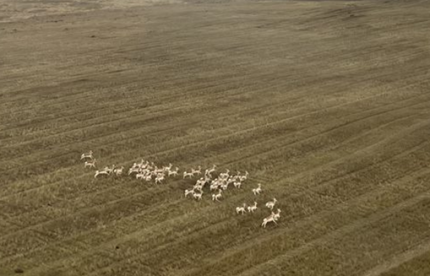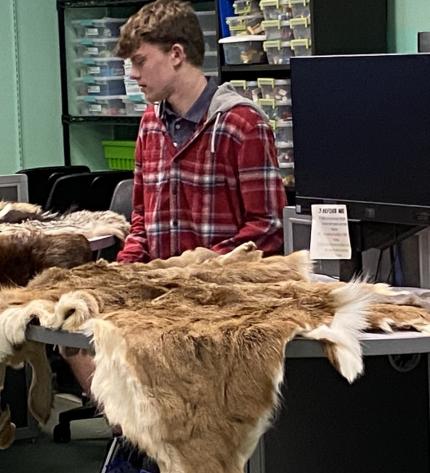Managing Wildlife Populations
Greater Sage-grouse: Biologists Eilers and Jeffreys and Technicians Hara and Force surveyed greater sage-grouse leks (communal display grounds for males). Biologists across Douglas County will be surveying for sage-grouse and Columbian sharp-tailed grouse, both of which are classified as endangered by the State of Washington. They are monitoring known current and historic leks to count birds for the purpose of generating a population estimate.
Biologists and other Washington Department of Fish and Wildlife (WDFW) staff members and agency partners will be conducting an intensive search for previously unknown leks by driving county roads and stopping every half mile to get out and listen for the vocalizations grouse often make while displaying. Douglas County currently has the greatest abundance of greater sage-grouse in Washington, but populations are declining. With this year’s increase in survey efforts, biologists hope to find more lek sites for both species and locate leks that were displaced by the Pearl Hill Fire. For more information on greater sage-grouse in Washington, visit the Washington Department of Fish and Wildlife website at Greater sage-grouse | Washington Department of Fish & Wildlife.


Private Biologist Braaten continues sage grouse lek counts in Douglas County. Biologist Morris started sage grouse searches. He will be searching grids in Douglas County without known sage grouse leks, searching for birds or new leks.

Pronghorn Aerial Survey: Washington Department of Fish and Wildlife Biologists Jeffreys and Eilers joined Biologist Rushing, a wildlife biologist for the Confederated Tribes of the Colville Reservation (CTCR), in performing an aerial survey for pronghorn across Douglas County.
Pronghorn were extirpated from Douglas County by the late 1800s. The Confederated Tribes of the Colville Reservation introduced 52 pronghorn to the Colville Reservation in 2016, and 98 in 2017, many of which swam across the Columbia River to Douglas County. The pronghorn they introduced were from Nevada.
A minimum of 103 individual pronghorn were observed during the aerial survey, predominantly in the Sim’s Corner and Leahy Junction areas. Surveys conducted on the Colville Reservation the week prior found approximately 120 pronghorn. For more information on pronghorn in Washington, visit the Washington Department of Fish and Wildlife website at: Pronghorn Antelope | Washington Department of Fish & Wildlife.



Mule Deer Collars: Hunter Education Coordinator Montanari retrieved one additional GPS collar from a mule deer to download the data that was stored onboard. Between 2020 and 2022, more than 60 does were collared in Chelan County as part of an ungulate movement and migration study being conducted in several Washington herds as well as across the western United States. Biologists have used location data gleaned from these GPS collars to learn valuable information about timing and duration of migration, migratory corridors and stopover points, and winter and summer range use for mule deer wintering in the Wenatchee Foothills as well as the Nahahum Canyon, Burch Mountain, and Swakane areas.
These collars were programmed to drop off in four years after deployment, so the last 12 collared does still standing since the January 2020 capture dropped their collars as scheduled last month. Biologists have recovered four of these collars so far and will continue to go after the other eight in the coming months. Washington Department of Fish and Wildlife will continue to receive GPS data from the approximately 13 collars still active on does in Chelan County for two more years.

Pygmy Rabbit Surveys: Biologist Morris helped with more pygmy rabbit surveys. The lack of snow on the ground made surveys more difficult, but some burrows in a known occupied area showed activity. A lot of cottontails were also seen.

Mule Deer Methow Winter Range Closure: The Methow Wildlife Area winter range closure is still in effect until April 1. Even though it’s been an unseasonably mild winter and early spring, collar data shows migratory mule deer are still on their winter ranges. For example, staff members counted over 85 mule deer at the Golden Doe last week and collar data shows deer congregating in the shrub steppe area that recreationist tend to prefer. Staff members have been counting nearly 50 deer at Lewis Butte on a fairly regular basis, which is a huge increase from years past. Staff members also noticed increased deer use at Rizeor Lake and even saw a cow moose and her calf utilizing the closure area. Deer seem to be moving into the spring green up areas of the Big Buck in larger numbers the last few weeks. In summary, by reducing human disturbance at this critical time of year, the closure is proving beneficial to the Methow’s beloved and iconic herd of mule deer.

winter range closure boundary.
Providing Recreation Opportunities
Hunter Access: Biologist Morris checked fields enrolled in our Waterfowl Habitat and Access Program (WHAP). The late white goose season is currently open and ends at the end of the week.
Biologist Morris completed two Hunter Access contracts that landowners wanted to renew, one Hunt by Written Permission and one Feel Free to Hunt.
Providing Conflict Prevention and Education
Wolf Deterrence Outreach: Specialist Heilhecker and Wildlife Regional Program Manager Haug visited with Okanogan Conservation District staff members to discuss nonlethal wolf deterrence measures. They discussed wolf activity in the county and how to get the message of nonlethal deterrence measures out to the local community.
Radio Activated Guard Deployment: Specialist Heilhecker deployed a Radio Activated Guard (RAG) box near cattle feedlots and calving pens. Wolves were coming close to the feedlots due to an open carcass pit. The producer buried the carcass pit. The wolves continued to come to the buried pit for the following eight days before it tapered off to less frequent visits.
Conserving Natural Landscapes
Habitat Plots: The ground is clear and now it is time to start spring habitat management activities. Biologist Morris spent some time planning spring habitat management projects.
Biologist Cook visited two landowners in Grant and Adams counties to discuss options of habitat improvement. Potential projects include irrigated and non-irrigated tree and shrub planting to improve wildlife cover and food sources and stabilize drainage ditch banks. Other projects include no-till native grass seeding to improve stand diversity and Russian olive removal to reduce invasive species and open space for desirable plants. Some shrub replanting may occur this spring depending on nursery stock. Most projects will be implemented this fall or later.
Conservation Reserve Program: Biologist Morris spoke with a landowner about preserving sagebrush that could provide potential pygmy rabbit habitat. The landowner is re-enrolling land in the federally run Conservation Reserve Program and needs to reseed the field. Biologist Morris will recommend leaving portions of the field that contain mature sagebrush since pygmy rabbits occupy fields less than two miles away and could occupy the site in the future.
Part of the reason for preserving sagebrush areas is that it can take 10 to 20 years to get a stand of sagebrush that is mature, dense enough to support pygmy rabbits. Every time mature sagebrush is destroyed it resets the clock for another 10 to 20 years before the area could provide pygmy rabbit habitat again.
Limebelt Forest Thinning: Scotch Creek staff members resumed thinning small diameter trees in the forested portions of the Limebelt on the Scotch Creek Unit. The goals of the thinning are to eliminate conifer encroachment in and around aspen, reconfigure fuels, and restore historical stand densities.

Shrub Enclosure Removal: Scotch Creek staff members removed approximately 2000 feet of temporary deer fence that was installed back around 2010 to protect newly planted deciduous shrubs. In 2015, the Okanogan Complex Fire burnt a portion of the enclosure. The fence was repaired, and new plants were planted in 2016. The fence has reached its life span and most of the shrubs are tall enough to be out of browsing height of deer.
Boundary Fence Repair: Scotch Creek staff members repaired approximately one mile of boundary fence on the Similkameen-Chopaka Unit damaged by high water from the Similkameen River and one mile on the Tunk Valley Unit damaged by falling dead trees from the Tunk Block Fire in 2015.

Providing Education and Outreach
Grant Elementary School Science Fair: Administrative Assistant Jones and Biologists Cook, Morris, Nason, and Technician Balderston organized an outreach room for Grant Elementary School students and their families to learn more about wildlife resources. Mammal skulls and skins, amphibian and reptile skeletons, and an insect coloring and cutout activity were provided for the public. Washington Department of Fish and Wildlife stickers and pamphlets were also available for families.





Conducting Business Operations and Policy
Natural Resource Conservation Service Local Working Group Meetings: Biologist Cook attended the West Palouse Local Working Group meeting in Ritzville and Biologist Morris attended the North Central Local Working Group meeting in Chelan. During these meetings, local priorities are decided for ranking Environmental Quality Incentives Program (EQUIP) proposals for the following fiscal year. Cook and Morris provided feedback and suggestions to include terrestrial wildlife habitat as a priority in the Rangeland Improvements Category.
Private Lands Work Party Planning: Private Biologist Braaten worked on planning an upcoming statewide Private Lands work party in north central Washington March 26 through March 28.
Region 2 North Community Collaborations: Assistant Regional Wildlife Program Manager Troyer has recently engaged in a variety of community collaborations. For example, Troyer recently attended the Chewuch Canal Company meeting to discuss future infrastructure improvements that would better serve irrigators, but also conserve more water for in-stream flows. Additionally, Troyer ran into a variety of other Washington Department of Fish and Wildlife colleagues at a Natural Resource Conservation Service workshop in Chelan. Lastly, Troyer has been busy as a core planning team member on Okanogan County’s Community Wildfire Protection Plan efforts.
Other
Damage Claim Processing: Specialist Heilhecker gathered notes and documentation for a deer damage crop compensation claim.
Permit Database Development: Specialist Heilhecker provided comments to a draft users’ manual for the new damage permit database system.
Wildlife Observed: While out checking local conditions Biologist Morris spotted several swans and bald and golden eagles, in agricultural fields near Quincy.

